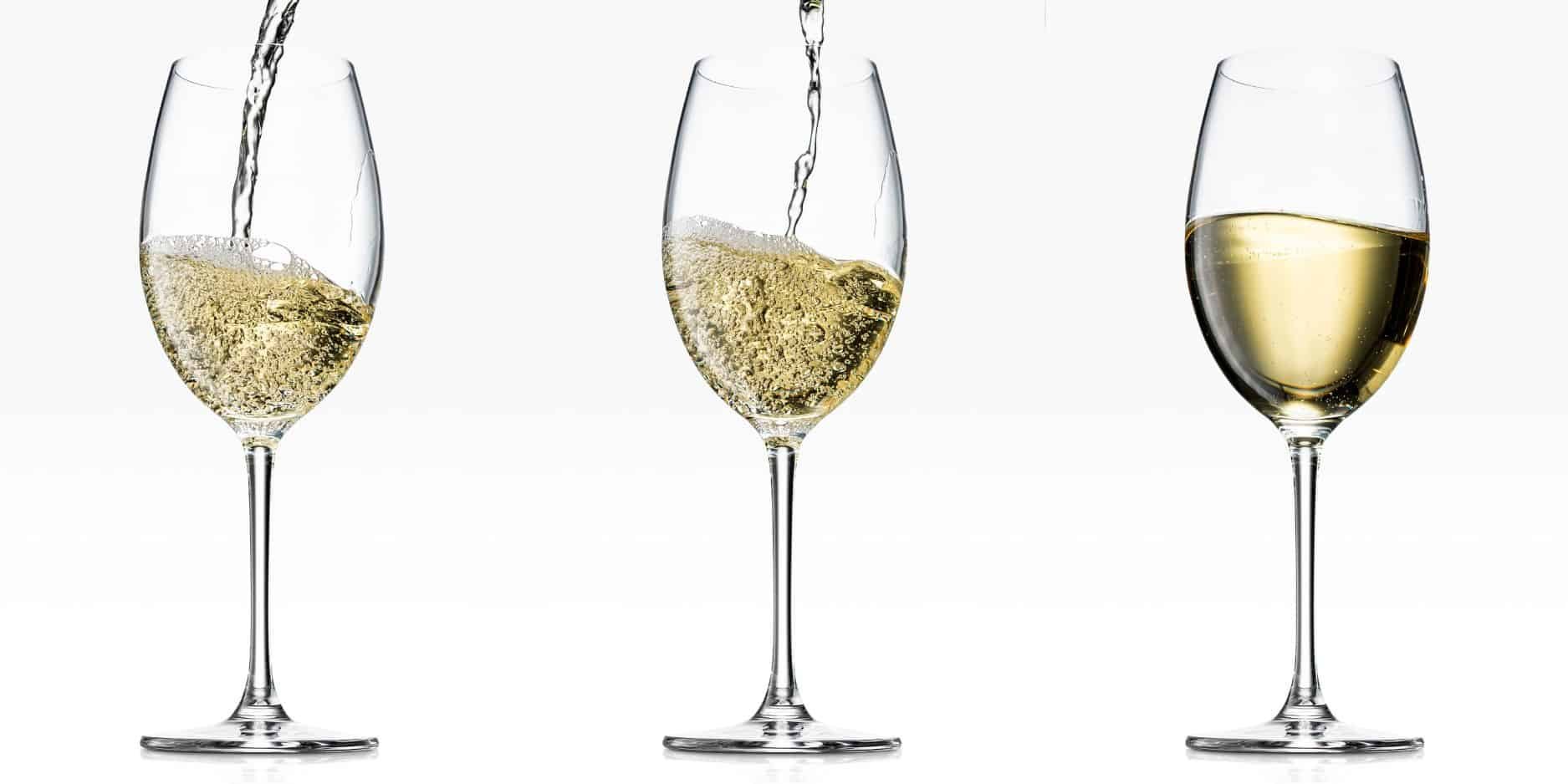Moscato vs. Riesling vs. Gewurztraminer: What's the Difference?
"It's a celebration/ clap clap bravo / lobster and shrimp / and a glass of Moscato" -Drake
Have you ever wondered: what are the main differences between Moscato, Riesling, and Gewurztraminer? If so, you aren't alone. You may have heard about Moscato from your favorite hip-hop stars or sipped a sweet Riesling or Gewurztraminer at a local wine tasting. These three white wine grapes have some similarities– but many differences too.
If you like sweet wines, you're in good company! According to Nielsen, more than 30% of the bottles sold in the U.S. are sweet wines. It's a $1 billion industry in the United States, and during the pandemic, sweet wine sales rose over 40%! One in three wine consumers started their journey into wine by sipping something with a bit of sweetness.
Let's go over the main differences between these three grape varieties- and which should be in your wine glass, depending on your palate!
What you need to know about Moscato
Moscato is a fruity wine with a sweet taste made from the Muscat Blanc grape, and it goes back to the ancient Greeks (these historic wines are made from a grape called Muscat Blanc à Petits Grains). Moscato can be made in still and sparkling styles– but most commonly, in a gently fizzy wine style called 'frizzante’. This is a mildly effervescent, foamy style (I went into more depth on this in my column at Martha Stewart if you'd like to check it out!)
Moscato has a low alcohol content, which makes it perfect for brunch! You can have a glass or two without feeling sluggish, sleepy, or tipsy. The fermentation process for Moscato leaves a little more residual sugar, giving the wine a lovely sweetness. But, since the best growing areas for Moscato are in cool climates, the wine retains a crisp acidity level that keeps the sweetness from being cloying.
There's a variation on the classic called 'Pink Moscato'… as far as pink wines go, it's not made in the way of a classic rosé. It's simply a white Moscato with a splash of red wine added for color, and the flavor profile is very similar to that of a white Moscato.
As for Red Moscato– these can differ widely depending on the winery. Some are made from a red grape variety called Black Muscat, and others are made from classic white Muscat blended with Syrah or Zinfandel.
The rolling hills of Piedmont, Italy, where Moscato d’Asti is grown
What Moscato tastes like
An easy-drinking, pleasantly sweet wine, it's easy to see why Moscato is so popular!
Here are typical aromas and flavors in Moscato:
Fruity notes: peaches, apricots, Meyer lemon, nectarines, mandarin orange
Floral qualities: orange blossom, honeysuckle, elderflower
Unusual aromas: honey
Growing regions for Moscato
Moscato grapes are grown all over the world. In fact, Muscat– the main grape in Moscato– is one of the most widely grown grape varieties and certainly one of the oldest. When Ancient Greek poets wrote of sweet wine, this is no doubt what they were referring to.
Southern France
It's widely believed in the wine world that the Romans brought the first Muscat vines to Narbonne, France. You can find this grape in some of the most famous sweet dessert wines of the area: Rivesaltes, Baumes-de-Venises, Banyuls, and Maury (where it's commonly blended with Grenache).
Great French Muscat-based blends to try: Chateau du Trignon Muscat Beaumes de Venise (500ML) 2012, Vidal-Fleury Beaumes de Venise Muscat (375ML half-bottle) 2019, Muscat Blanc de Rivesaltes Mas des Caprices 2021
Italy
In the Piedmont region of Northern Italy, we find perhaps the most celebrated Moscato in the world: Moscato d'Asti. (If you've had Asti Spumante– the sparkling wine of the Asti region– it was likely a Moscato!) This expression is beloved by sommeliers for its floral aromas, delicate flavor, and crisp finish.
In Southern Italy and Sicily, Muscat is known as Zibibbo, produced as an outstanding sweet dessert wine, Passito from Pantelleria.
Great Italian Moscato to try: Vietti Moscato d'Asti 2021, Fontanafredda Briccotondo Moscato d'Asti 2021, and Ceretto Santo Stefano Moscato d'Asti 2020
Spain
In Spain, look for Moscatel, which you'll also see in Portugal. Spanish regions growing this grape include Malaga, Valencia, Andalucia, and the Canary Islands.
Great Spanish Moscatel to try: Cesar Florido Moscatel Especial (375ML Half-bottle), Bodegas Jorge Ordonez Malaga Botani Old Vines Moscatel 2021
Other regions:
Excellent muscat-based wines are also grown and made in Australia, California, and South Africa.
Best food pairings for Moscato
Because it's so light and pleasant, Moscato is a great choice with fresh, herbal flavors. I absolutely love it with Vietnamese food! I highly recommend you explore Andrea Nguyen's recipes on her site, Viet World Kitchen. With Moscato, pair Pan-Seared Egg Tofu "Scallops" With Sweet Chile Sauce or Wok-Seared Shrimp, Garlic And Chile.
Because Moscato is sweet, you can try a contrast pairing and pick a spicy dish: why not try Buffalo Wings or a spicy queso dip?
My personal favorite pairing for Moscato is cheese. Slightly funky washed-rind cheeses like Taleggio are a dream with Moscato! Or make a night of it and pair Moscato with a Charcuterie Board.
Vietnamese summer rolls are a terrific pairing for Moscato wine!
What you need to know about Riesling
Originally from Germany, Riesling is a white grape variety that's now grown all over the globe. It produces one of the most popular white wines in the world that's beloved by both everyday wine drinkers and sommeliers-- and once you get to know it, it's easy to see why!
First, it's an incredibly versatile, aromatic wine: it is made in a sweet version and many dry versions. You can buy bottles that are either fresh or aged, and Riesling is made in both still and sparkling styles. Basically, there's a Riesling out there for every palate. They're expressive wines-- depending on where they're grown, each bottle has a different dimension.
If you're looking for wines that can age, Riesling is one of the best white wine options to mature in their cellar. These wines age incredibly well due to their high natural acidity, which is a protectant and preservative. You can keep these bottles in your cellar for years, and they will only get more interesting.
Alsace, France: home to some of the world’s greatest Rieslings
What Riesling tastes like
Riesling is an intensely aromatic grape: its abundant fragrances bounce right out of the glass! It has a pale straw color that can turn golden when aged.
Here are typical aromas and flavors in Riesling:
Stone fruit: peach, nectarine, and apricot.
Fresh, tart fruits: green apple, pear, lemon, lime, and other flavors of citrus
Floral notes: honeysuckle, jasmine
Unusual aromas: a rubbery or gasoline-like smell referred to by wine experts as 'petrol.'
On the palate, one thing that distinguishes Riesling is its higher acidity. Even the sweeter styles have a mouthwatering tartness to them (think about lemonade, which can be brisk and crisp while being sweet at the same time: that's the kind of acid profile we're talking about).
Will your bottle be dry, medium-dry, medium-sweet, or sweet? The International Riesling Foundation has created a scale graphic called Riesling Taste Profile to help consumers understand what they're getting: it's located on the back label of millions of bottles of Riesling!
Without depending on the scale, you can expect dry rieslings from Alsace, New York's Fingerlakes region, Washington State (especially if it's labeled 'Dry Riesling'), and wines from Germany labeled 'Trocken'-- which means dry. In general, you can expect under-$10 bottles of Riesling to be sweet.
The main growing regions for Riesling
Germany
The birthplace of Riesling, Germany, has 56,000 acres of Riesling grapes! Look for Riesling wines for the Pfalz, Mosel, and Rheinhessen regions. Germany has a labeling system that makes choosing your wines simple:
Kabinett is the lightest style; these wines are dry or off-dry.
Spätlese (meaning late-harvest) is richer and sweeter than Kabinett
Auslese (select harvest) are hand-selected and very sweet.
For dessert wine, look for Beerenauslese, Trockenbeerenauslese, and Eiswein-- these are all made from grapes that have been raisinated on the vine, so their sugars are very concentrated, hence producing a very decadent and sweet dessert wine.
Great German Rieslings to try: Clean Slate Riesling 2019, Donnhoff Niederhauser Klamm Riesling Kabinett 2021, Schloss Johannisberg Rheingau Riesling Feinherb Gelback 2018, and Robert Weil Estate Riesling Spatlese 2021.
United States
The two primary wine regions for Riesling in the U.S. are New York's Fingerlakes and Washington's Columbia Valley. In 1958, Dr. Konstantin Frank planted Riesling on the western shores of the Finger Lakes. The grape thrived in the frigid climate-- it showed the potential for New York State as an emerging wine region for high-quality Riesling, and today many of the area's wines are acclaimed worldwide.
In Washington state, Riesling was first planted in Yakima Valley in 1967, and today there are over 5,000 acres of Riesling grapes planted there, making it the largest production area of Riesling in the country. The Columbia Valley has very cool evenings, which help preserve Resling's high acidity.
Great U.S. Rieslings to try: From New York, try Dr. Konstantin Frank Dry Riesling 2021. And from Washington, try Poet's Leap Riesling 2020 or Eroica Riesling 2021.
Australia
You might know Australia as home to big, bold, and spicy Shiraz wines-- so you might be surprised to find out that Riesling has been one of the primary grapes planted since the mid-1800s. Most Australian Riesling is bone dry with sharp acidity and bright fruit.
Clare Valley and Eden Valley are the main areas to look out for. Clare Valley has a warmer climate but dramatic day-to-night temperature swings and high elevations, which keep things nice and cool. You'll experience a lot of minerality in Clare Valley wines. Eden Valley has some of the world's oldest Riesling vines and will be more fruity and floral. Great options are Pewsey Vale Eden Valley Riesling 2021, Pikes Hills and Valleys Riesling 2021, and Jim Barry Lodge Hill Riesling 2019.
France
One of the most prized places to make Riesling is the Alsace region of France-- not surprising considering Alsace's long political history of Germanic ownership influence. Alsace is known for concentrated, dry-style Riesling with a laser-sharp acid structure. White flowers and citrus aromas are typical, followed by flavors of peach and pear and a mineral finish. Great Alsatian Rieslings to try: Trimbach Riesling 2020, Willm Cuvee Emile Willm Riesling 2020, and Pierre Sparr Riesling 2020.
The best food pairings for Riesling
Riesling pairs well with spicy food and Asian flavors.
Sommeliers adore Riesling because it's one of the most food-friendly wines- the delicate, dry styles are perfect with seafood. The sweeter styles can counter the heat in spicy dishes, and rich, luscious stiles are excellent with cheeses or even sipped as dessert wines.
Riesling's more delicate and dry styles are a good choice with light seafood dishes and vegetable salads. Try Dungeness Crab Salad, Peekytoe Crab Toast, and Cucumbers with Lemon and Basil.
For a sweet style Riesling, pair with spicy food or Asian food: Chili-Glazed Fried-Chicken Lettuce Cups, Five-Spice Pork Tenderloin, or Thai Green Shrimp Curry.
And for rich, dessert-style rieslings, pair Blue Cheese Gougeres with Caramel and Salt or Lemon Custard Tarts.
What you need to know about Gewurztraminer
Gewurztraminer (guh-VERTZ-tra-mee-ner) might be hard to pronounce, but it's easy to drink! Get to know this aromatic white wine.
Picturesque Alto Adige, Italy: a world class destination for Gewurztraminer wine
What Gewurztraminer tastes like
Gewurztraminer is an aromatic grape variety that produces a full-bodied white wine. The German word 'Gewurz' means 'spicy'-- but the wine doesn't show a spicy character; instead, the term stands for 'strong aroma. The most notable thing about this wine is how powerful its fragrance is! An, its rich, slightly oily texture.
Here are typical aromas and flavors in Gewurztraminer
Floral notes: rose petals, orange blossom
Stone fruits: peach, apricot
Citrus fruit: orange peel
Tropical fruit qualities: lychee, pineapple
Unusual aromas: ginger
Gewurztraminer, in general, is a sweeter wine-- it will usually have a couple of grams of residual sugar, and even the bottlings that are technically 'dry' (meaning all of the natural sugars have been fermented into alcohol, and there's no trace of sugar as it would be measured in a lab) are still perceived by our palates as sweet, because of all those tropical fruit notes!
Gewurztraminer has a relatively high alcohol content and low acidity, which can also enhance our perception of sweetness. It has a golden color, or sometimes a copper tone– because its skins are pink (instead of the pale green we see in most white grapes).
Growing Regions for Gewurztraminer
France
The French region of Alsace is arguably the most important growing area for Gewurztraminer. Riesling, Pinot gris, and Muscat are among the four grapes allowed in the highest-quality Alsatian wines (called Grand Crus). For hundreds of years, Alsatian Gewurztraminer wine has been made as a table wine and in a late-harvest dessert wine style called Vendange Tardive: these are the top wines, so if you see that on a label, don't hesitate to put it in your cart!
You can expect a more dry style from Alsace (compared to Italy, where the Gewurztraminer wines are typically sweeter). Excellent Gewurztraminer wines from Alsace include Hugel Gewurztraminer 2018, Trimbach Gewurztraminer Tradition 2018, and Zind-Humbrecht Gewurztraminer 2020.
Italy
Gewurztraminer makes up about ten percent of the total growing area of the Alto Adige region in Northern Italy. Italian Gewurztraminer tends to be lighter and less intense than the version made in France and is sometimes sweeter. It grows mainly in the most southern area, Bassa Atesina, which is temperate due to the influence of nearby Lake Garda. Try Elena Walch Kastelaz Gewurztraminer 2021, or Tramin Nussbaumer Gewurztraminer 2021.
United States
Gewurztraminer wines were once some of the most popular in California, but as sweeter wines have become a bit less popular, the Gewurztraminer vineyards were slowly replanted to Chardonnay. Gewurztraminer may be produced by fewer wineries than it once was, but the ones still available are delicious: try Alexander Valley Vineyards Gewurztraminer 2021 from Mendocino.
Washington State has also been producing luscious Gewurztraminer, and the cooler climate there helps keep the sugars from spiking too much. I recommend Chateau Ste. Michelle Gewurztraminer 2021. And Gewurztraminer from New York's Fingerlakes region is worth watching; Ravines Gewurztraminer 2018 is a fantastic example.
The best food pairings for Gewurztraminer
Try Gewurztraminer wines paired with soft cheeses- yum!
Because of its natural sweetness, Gewurztraminer wine is an excellent pairing partner with spicy dishes: it's delicious paired with Thai Green Shrimp Curry.
In addition, dishes with tropical fruit have a natural harmony with the wine; try Fresh Mango-Lobster Spring Rolls. Another fun pairing is Moroccan food; the apricot, warm ginger spices, and rosewater flavors in many dishes are a good match for Gewurztraminer: try it with Sea Scallops with Sherry and Saffron Couscous and Moroccan-Spiced Chicken.
And when in doubt, the aromatic intensity of Gewurztraminer is a lovely match with semi-soft cheeses.











